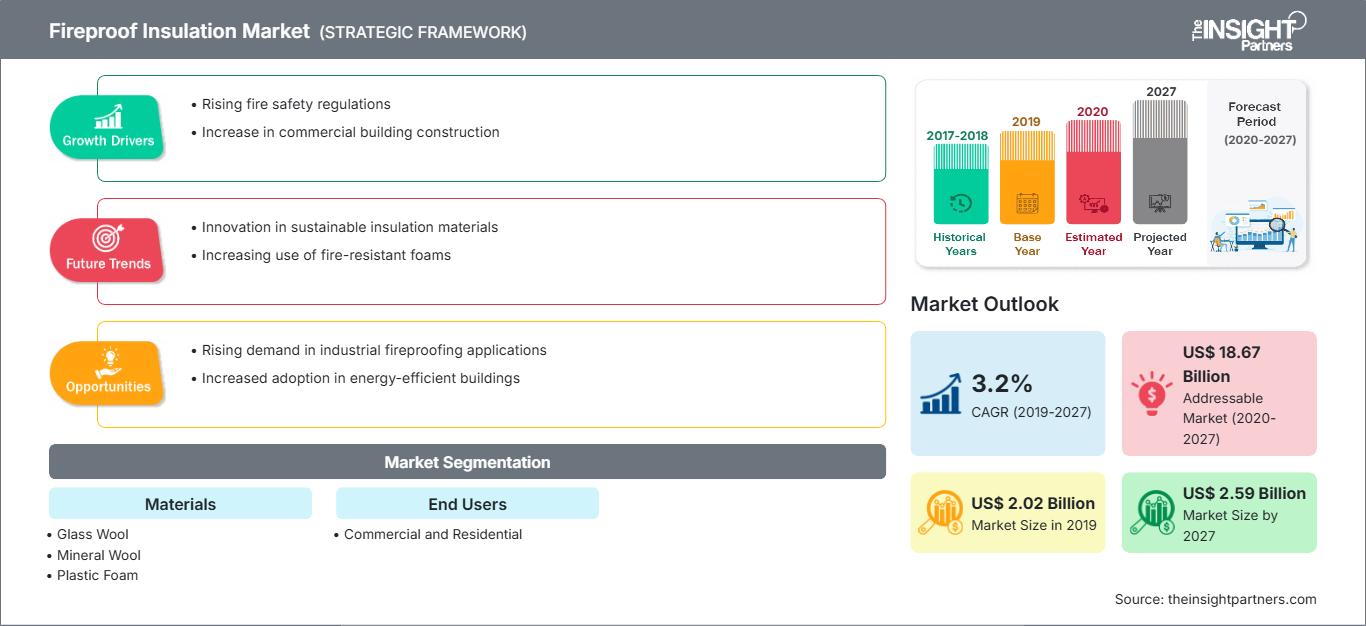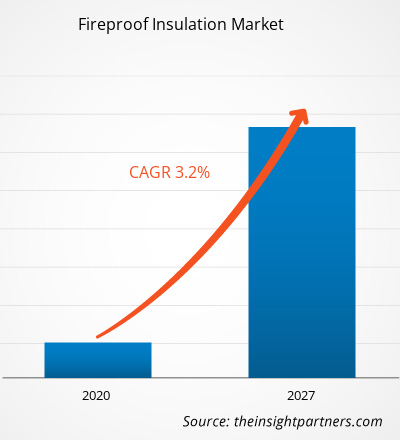[Forschungsbericht]Der Markt für feuerfeste Dämmstoffe hatte 2019 einen Wert von 2,02 Milliarden US-Dollar und soll bis 2027 voraussichtlich 2,59 Milliarden US-Dollar erreichen; im Prognosezeitraum 2020 bis 2027 wird ein durchschnittliches jährliches Wachstum von 3,2 % erwartet.
Feuerfeste Dämmstoffe tragen dazu bei, durch Feuer verursachte Schäden zu reduzieren. Feuerfeste Dämmstoffe sind in fünf Formen erhältlich: Schaum, Schnittfasern, Platten- oder Blockdämmung, Fasermatten sowie Textilien, Filme und Folien. Die Widerstandsfähigkeit der einzelnen Formen hängt vom Material ab, aus dem sie hergestellt sind. Aufgrund der strengen Brandschutznormen und der zunehmenden Bautätigkeit im Wohnungsbau ist die Nachfrage nach feuerfesten Dämmstoffen im Wohnbau hoch. Auch im gewerblichen Bereich erfreut sich feuerfester Dämmung aufgrund der zunehmenden Bedeutung des Brandschutzes zunehmender Beliebtheit. Darüber hinaus nehmen die Bau- und Sanierungsaktivitäten sowohl in Industrie- als auch in Entwicklungsländern deutlich zu, was sich voraussichtlich positiv auf den Markt für feuerfeste Isolierungen auswirken wird.
Der Markt für feuerfeste Isolierungen in der Region Asien-Pazifik wird im Prognosezeitraum voraussichtlich die höchste durchschnittliche jährliche Wachstumsrate (CAGR) aufweisen. Das Marktwachstum in dieser Region ist hauptsächlich auf die hohe Bevölkerungszahl zurückzuführen, die eine hohe Nachfrage nach Gewerbe- und Wohnungsbau mit sich bringt. Darüber hinaus führt das Wachstum der gewerblichen Bautätigkeit im Nahen Osten (MEA) zu einer steigenden Nachfrage nach feuerfesten Isolierungen in der Region. So finden in der Region beispielsweise die Expo 2020 in Dubai, die FIFA Fußball-Weltmeisterschaft 2022 in Katar, das Rote Meer und Neom sowie Al Qiddiya in Saudi-Arabien statt. Der Bau der oben genannten Projekte umfasst enorme Bauwerke und erfordert deutlich höhere Sicherheitsstandards. Südamerika verzeichnet jedoch seit Jahren ein schleppendes Wachstum, und es wird erwartet, dass der Markt für feuerfeste Isolierungen in der Region nur langsam wachsen wird.
Passen Sie diesen Bericht Ihren Anforderungen an
Sie erhalten kostenlos Anpassungen an jedem Bericht, einschließlich Teilen dieses Berichts oder einer Analyse auf Länderebene, eines Excel-Datenpakets sowie tolle Angebote und Rabatte für Start-ups und Universitäten.
Markt für feuerfeste Isolierung: Strategische Einblicke

-
Holen Sie sich die wichtigsten Markttrends aus diesem Bericht.Dieses KOSTENLOSE Beispiel umfasst Datenanalysen, die von Markttrends bis hin zu Schätzungen und Prognosen reichen.
Der COVID-19-Ausbruch beeinträchtigt Wirtschaft und Industrie in verschiedenen Ländern aufgrund von Lockdowns, Reiseverboten und Betriebsschließungen. Die Chemie- und Werkstoffindustrie gehört zu den wichtigsten Branchen, die unter schweren Störungen wie Lieferkettenbeschränkungen und Produktionsschließungen leiden. Die Schließung verschiedener Werke und Fabriken in verschiedenen Ländern unterbricht die globalen Lieferketten und wirkt sich negativ auf Produktionsaktivitäten, Lieferpläne und den Verkauf zahlreicher Waren aus. Verschiedene Unternehmen haben bereits mögliche Verzögerungen bei Produktlieferungen und einen Rückgang der zukünftigen Produktverkäufe angekündigt. Darüber hinaus behindern die weltweiten Reiseverbote in Ländern Europas, Asiens und Nordamerikas die Geschäftskooperation und Partnerschaften. Diese Faktoren bremsen somit das Wachstum des Marktes für feuerfeste Isolierung in der Chemie- und Werkstoffindustrie.
Markteinblicke: Die steigende Nachfrage nach energieeffizienten Dämmstoffen zur Senkung der Treibhausgasemissionen dürfte das Marktwachstum für feuerfeste Isolierung ankurbeln
Die Hauptfunktion der Isolierung besteht darin, den Wärmefluss innerhalb und außerhalb des Hauses zu kontrollieren und zu regulieren. Energieeffiziente Lösungen helfen, die Energieeffizienz in Unternehmen und Haushalten zu steigern und gleichzeitig Geld zu sparen. Verschiedene Arten von energieeffizienten Lösungen werden im Wohn- und Industriesektor weithin eingesetzt und tragen so zur Reduzierung der Treibhausgasemissionen bei. Der Einbau einer Isolierung führt zu einer massiven Reduzierung von Energieverschwendung und Energiekosten. Dämmmaterialien wie Schaumstoff spielen eine wichtige Rolle bei der Isolierung von Gebäuden. Sie füllen die Lücken, durch die potenziell Luft eindringen kann, und schaffen eine energieeffiziente Umgebung in einem Gebäude. Aufgrund seiner effektiven und leistungsstarken Dämmeigenschaften ist Sprühschaum eine attraktive Investition für Kunden, die ihr Eigentum im Brandfall schützen möchten. Polyurethan-Sprühschaum-Isolierung ist eine weitere Schaumart, die zum Füllen und Isolieren großer Hohlräume und Flächen verwendet wird. Dieses Material trägt zur Verbesserung der Raumluftqualität bei und senkt die Kühl- und Heizkosten bei gleichzeitiger Senkung des Energieverbrauchs. Unternehmen wie ROCKWOOL International A/S, John Manville, Knauf Insulation GmbH und InSoFast, LLC bieten feuerfeste Isolierungen an.
Materialeinblicke
Basierend auf dem Material ist der Markt für feuerfeste Isolierungen in Glaswolle, Mineralwolle, Kunststoffschaum, Glasfaser, Polyurethanschaum und andere unterteilt. Das Segment Glaswolle hatte 2019 einen größeren Marktanteil. Glaswolle wird aus recyceltem Glas und geschmolzenem Sand wie Soda, Kalkstein und Sand hergestellt, wodurch Luft eingeschlossen und Wärme, Lärm und Kälte blockiert werden. Das Material ist leicht, schädlingssicher und flexibel und wird daher häufig zur elektrischen und thermischen Isolierung in Gebäuden eingesetzt. Das Material wird auf Dachböden ausgelegt, um die Temperatur im Gebäude auszugleichen. Glaswolle absorbiert Schallenergie und wird verwendet, um die akustische Leistung von Decken, Wänden, Dächern und Böden zu verbessern. Die Fasern der Glaswolle sind nicht brennbar und werden daher zur akustischen oder thermischen Isolierung verwendet. Da dieses Material aus recycelten Materialien wie Glas, Schlacke und anderen industriellen Nebenprodukten hergestellt wird, ist es nachhaltiger.
Einblicke für Endnutzer
Basierend auf dem Endnutzer ist der Markt für feuerfeste Isolierung in Wohn- und Gewerbeimmobilien segmentiert. Der Wohnbereich hatte 2019 den größten Marktanteil. Die Zahl der Bauprojekte im Wohnsektor steigt in Volkswirtschaften wie China, Indien, den Philippinen, Polen und Russland exponentiell an. Beim Hausbau werden verschiedene Arten von Isolierung verwendet, darunter auch Feuerfestigkeit. Manchmal bringen die Hausbesitzer die Materialien und Decken je nach Bedarf selbst an, während andere Arten der Isolierung professionell installiert werden müssen. Im Wohnungsbau werden Schaumstoffplatten hauptsächlich an der Innenseite der Wand bestehender Häuser und an der Außenseite der Wand bei Neubauten angebracht. Isolierung ist ein wichtiger Bestandteil von Häusern, um den Energieverbrauch zu senken. Durch den Einsatz von Isolierungsmaterialien können Hausbesitzer durchschnittlich 15 % der Kühl- und Heizkosten und 11 % der Gesamtenergiekosten einsparen. Laut der North American Insulation Manufacturers Association sind in den USA mehr als 70 % der Einfamilienhäuser nicht ausreichend gedämmt. Dieser Aspekt würde dazu beitragen, den Einsatz von Dämmstoffen in Wohngebäuden zu erhöhen. Fasermatten, Mineralwolle und Glasfaser gehören zu den wichtigsten Dämmstoffen, die im Wohnbereich häufig verwendet werden.
Einige Akteure auf dem Markt für feuerfeste Dämmstoffe sind Saint Gobain SA, BASF SE, Johns Manville, Kingspan Group PLC, Lloyd Insulations (India) Limited, Owens Corning, ROCKWOOL International A/S, UP Twiga Fiberglass Limited, Knauf Insulation GmbH und L'ISOLANTE K-FLEX SPA, um nur einige zu nennen. Die wichtigsten Unternehmen setzen Fusionen und Übernahmen sowie Forschungs- und Entwicklungsstrategien um, um ihren Kundenstamm zu erweitern und bedeutende Marktanteile auf dem Weltmarkt zu gewinnen. Dies ermöglicht ihnen auch, ihren Markennamen weltweit zu behaupten.
Berichts-Spotlights
- Fortschreitende Branchentrends auf dem Markt für feuerfeste Isolierungen helfen den Akteuren bei der Entwicklung effektiver langfristiger Strategien
- Geschäftswachstumsstrategien in entwickelten und sich entwickelnden Märkten
- Quantitative Analyse des Marktes für feuerfeste Isolierungen von 2019 bis 2027
- Schätzung der weltweiten Nachfrage nach feuerfesten Isolierungen
- PEST-Analyse zur Veranschaulichung der Wirksamkeit von Käufern und Lieferanten in der Branche
- Jüngste Entwicklungen zum Verständnis des Wettbewerbsumfelds auf dem Markt
- Markttrends und -aussichten sowie Faktoren, die das Wachstum des Marktes für feuerfeste Isolierungen fördern und hemmen
- Unterstützung im Entscheidungsprozess durch Hervorhebung von Marktstrategien, die das kommerzielle Interesse untermauern und zum Marktwachstum führen
- Die Größe des Marktes für feuerfeste Isolierungen in verschiedenen Knoten
- Detaillierter Überblick und Segmentierung des Marktes sowie der Dynamik der feuerfesten Isolierungsbranche
- Größe des Marktes für feuerfeste Isolierung in verschiedenen Regionen mit vielversprechenden Wachstumschancen
Feuerfeste Isolierung
Regionale Einblicke in den Markt für feuerfeste IsolierungDie Analysten von The Insight Partners haben die regionalen Trends und Faktoren, die den Markt für feuerfeste Isolierungen im Prognosezeitraum beeinflussen, ausführlich erläutert. In diesem Abschnitt werden auch die Marktsegmente und die geografische Lage in Nordamerika, Europa, dem asiatisch-pazifischen Raum, dem Nahen Osten und Afrika sowie Süd- und Mittelamerika erörtert.
Umfang des Marktberichts über feuerfeste Isolierung
| Berichtsattribut | Einzelheiten |
|---|---|
| Marktgröße in 2019 | US$ 2.02 Billion |
| Marktgröße nach 2027 | US$ 2.59 Billion |
| Globale CAGR (2019 - 2027) | 3.2% |
| Historische Daten | 2017-2018 |
| Prognosezeitraum | 2020-2027 |
| Abgedeckte Segmente |
By Materialien
|
| Abgedeckte Regionen und Länder |
Nordamerika
|
| Marktführer und wichtige Unternehmensprofile |
|
Die Marktdichte der Akteure im Bereich feuerfeste Isolierung: Verständnis ihrer Auswirkungen auf die Geschäftsdynamik
Der Markt für feuerfeste Isolierungen wächst rasant. Die steigende Nachfrage der Endverbraucher ist auf Faktoren wie veränderte Verbraucherpräferenzen, technologische Fortschritte und ein stärkeres Bewusstsein für die Produktvorteile zurückzuführen. Mit der steigenden Nachfrage erweitern Unternehmen ihr Angebot, entwickeln Innovationen, um den Bedürfnissen der Verbraucher gerecht zu werden, und nutzen neue Trends, was das Marktwachstum weiter ankurbelt.

- Holen Sie sich die Markt für feuerfeste Isolierung Übersicht der wichtigsten Akteure
- Glaswolle
- Mineralwolle
- Kunststoffschaum
- Glasfaser
- Polyurethanschaum
- Sonstige
Markt für feuerfeste Isolierung – nach Endverbraucher
- Wohngebäude
- Gewerbegebäude
Firmenprofile
- Saint Gobain SA
- BASF SE
- Johns Manville
- Kingspan Group PLC
- Lloyd Insulations (India) Limited
- Owens Corning
- ROCKWOOL International A/S
- UP Twiga Fiberglass Limited
- Knauf Insulation GmbH
- L'ISOLANTE K-FLEX SPA
- Historische Analyse (2 Jahre), Basisjahr, Prognose (7 Jahre) mit CAGR
- PEST- und SWOT-Analyse
- Marktgröße Wert/Volumen – Global, Regional, Land
- Branchen- und Wettbewerbslandschaft
- Excel-Datensatz
Aktuelle Berichte
Verwandte Berichte
Erfahrungsberichte
Grund zum Kauf
- Fundierte Entscheidungsfindung
- Marktdynamik verstehen
- Wettbewerbsanalyse
- Kundeneinblicke
- Marktprognosen
- Risikominimierung
- Strategische Planung
- Investitionsbegründung
- Identifizierung neuer Märkte
- Verbesserung von Marketingstrategien
- Steigerung der Betriebseffizienz
- Anpassung an regulatorische Trends






















 Kostenlose Probe anfordern für - Markt für feuerfeste Isolierung
Kostenlose Probe anfordern für - Markt für feuerfeste Isolierung